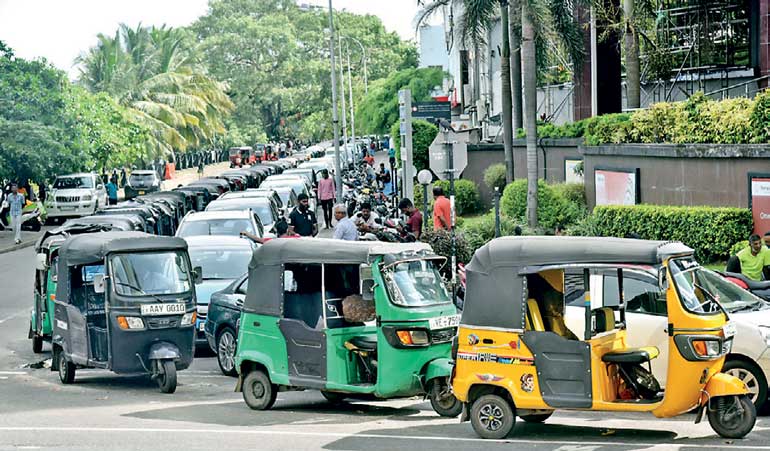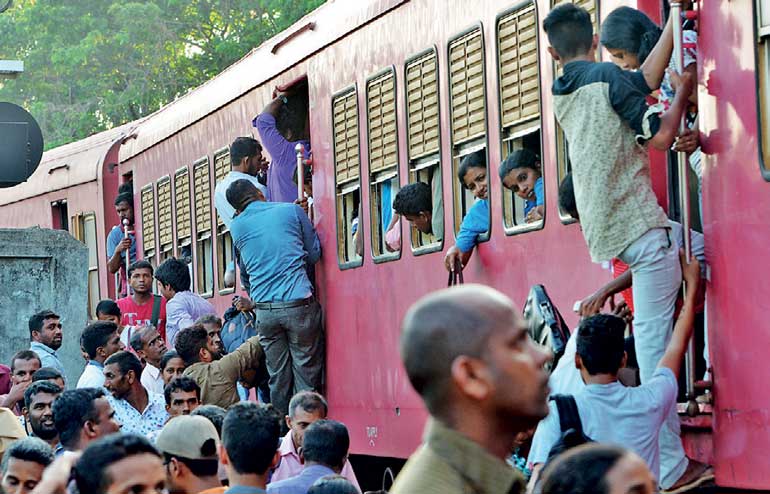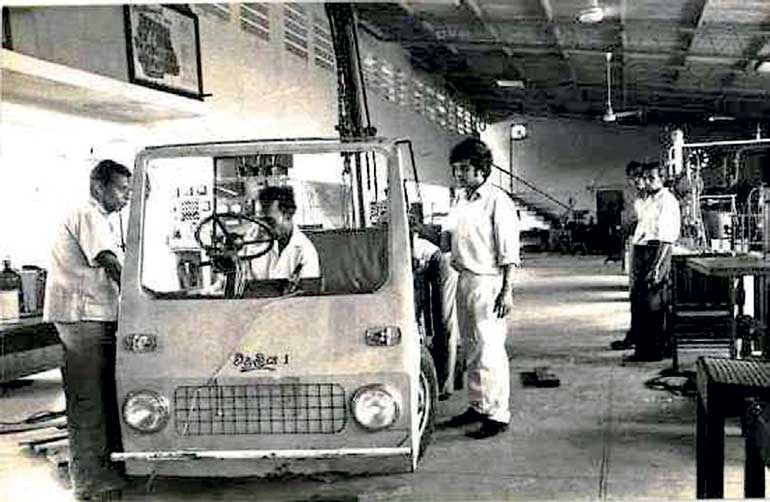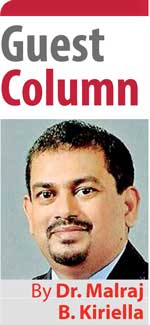Monday Apr 07, 2025
Monday Apr 07, 2025
Tuesday, 16 August 2022 01:08 - - {{hitsCtrl.values.hits}}



‘Viduliya 1’ – the first electric car made in Sri Lanka in 1977 by the Department of Mechanical Engineering of Moratuwa University – Pic courtesy: https://m.facebook.com/mechuom/photos/young-prof-p-a-de-silva-with-his-electric-car-úÿලිය-1-viduliya-1-captured-40-y/1205268996234950/
 As a first-year university student, I recall learning Comparative Economics, where my lecturer, using examples from the United States, the United Kingdom, Russia, Japan, and India, demonstrated how those countries increased their economic development by adopting various economic systems, including open, socialist, and mixed. Whatever system was adopted; it was apparent to me that the growth of a country’s transportation played a crucial role in its development. Some of these countries’ transportation development occurred in the 1800s, but as technology advanced, they were able to upgrade to more advanced modes of transportation.
As a first-year university student, I recall learning Comparative Economics, where my lecturer, using examples from the United States, the United Kingdom, Russia, Japan, and India, demonstrated how those countries increased their economic development by adopting various economic systems, including open, socialist, and mixed. Whatever system was adopted; it was apparent to me that the growth of a country’s transportation played a crucial role in its development. Some of these countries’ transportation development occurred in the 1800s, but as technology advanced, they were able to upgrade to more advanced modes of transportation.
Why transportation development is considered as the bedrock of any country’s growth? This is because it is impossible to realise a consistent growth and development of an economy without linking people (producers and consumers) and products (goods and services) cost effectively. Except for a few ad-hoc initiatives in the post-independence era, there has never been a comprehensive and nationally integrated transport plan where policymakers have prioritised this basic factor on their agenda.
Due to a lack of visionary leadership, Sri Lanka has lost the opportunity of making the country’s location as a strategic aviation and shipping hub in the region. The country is geographically endowed with the rare ability of connecting the East and the West. This has been a transiting point for various marine routes since ancient times. Because of their foresight, Singapore and Dubai took the advantage of the chance.
Singapore, which lagged behind Ceylon in attaining independence, received a total income of SGD 3.0 billion (approx. $ 2.3 b) from its airport revenue according to Changi Airport Annual Report 2019/20. Dubai, which began as a modest airport in the 1980s, is now thriving as an aviation hub, earning a total revenue of AED 14.8 billion (approx. $ 4.0 b) from its Dnata airport operations according to Emirates Group Annual Report 2019/20. The total economic impact of these countries’ aviation sectors on their national economies is $ 22.1 billion for Singapore (IATA, 2020) and $ 26.7 billion for the UAE (Oxford Economics, 2014).
The question is, “Where are we now?” The country is currently unable to pay its fuel import bill. According to the CBSL Annual Report 2021, the total fuel imports in 2020 were $ 3,742.9 million. Today’s prevalent difficulties include fuel shortages, long queues, conflicts and deaths in queues, black market sales, and unexpected fuel price rises. It is a country that still lacks a reliable and effective public transportation system. Many studies have been undertaken, several international study visits have taken place, consultants have been hired, and several plans have been devised, with the million-dollar question being, where is the implementation?
I see a lot of posts on social media these days of people, including high-status individuals, who used to favour luxury vehicles but now choose public transportation such as buses, trains, or tuk-tuks, or even walking. I believe that everyone should work together to create an efficient and effective public transportation system for this country as a long-term sustainable solution. It should not be found only when the problem arises, which has been the common culture in this country.
The lack of an integrated transportation policy encouraged the autonomous development of various forms of transportation, resulting in a fragmented transportation sector with dispersed services. Apart from public transportation, it is common to notice that the low and lower middle-income groups use motorbikes and three-wheelers, whilst the upper middle- and high-income groups utilise cars, vans, and jeeps, including semi-luxury and luxury vehicles. Because of the inadequacy of the public transportation system and the general lack of concern for societal issues, many affordable people embrace the “My vehicle, my fuel” mentality.
Among other Asian countries, where overpopulation of vehicles and motorcycles causes considerable traffic congestion and pollution in many of their metropolitan centres, Singapore is a clear example of how to discourage the use of personal vehicles. Sri Lanka’s successive governments have on the other hand prioritised expensive road and infrastructure expansion over improving public transportation.
During the British occupation, the railway system was initially used to deliver plantation products such as tea and rubber to Colombo. It then evolved into a passenger transportation service. Despite a few endeavours, Sri Lankan governments did not build new railway lines or extend those that were already in place. Some routes were closed, including one from Avissawella to Ratnapura and then to Opanayake. I remember making the final journey from Ratnapura to Opanayaka when I was a small child. All lands of these railway lines were occupied by the public, who subsequently erected unauthorised constructions on land belonging to the Department of Railways.
Train transport today has its own set of issues, including flaws in track networks and carriages, ‘outdated’ rail network signalling and telecommunication systems, a lack of technology, and trade union strikes. Sri Lanka Railways posted an operating loss of Rs. 10.3 billion according to CBSL Annual Report, 2021 and is seen as yet another white elephant “at the expense of a heavy subsidy requirement on the Government Treasury and thus the citizens”.
The Government previously sought to implement a light train project connecting Colombo City and its immediate suburbs, but it was abandoned due to some reasons. In the SAARC area Asia, India (13 cities and began in 1984 in Kolkata), Pakistan (Lahore in 2020), and Bangladesh (Dhaka set to begin in December, 2022) have all established urban Mass Rapid Transit (MRT) systems.
The most pressing question at this hour is how to obtain fuel. However, the country must find an appropriate solution to its transportation problem in the future. The current situation is exacerbated by the lack of an appropriate national transportation policy. It is well known that our per capita fuel consumption is very high, indicating that we are living beyond our means. Even for a single kilometre, we consume imported fuel. Our road system was designed mainly for vehicular traffic, with little regard for pedestrians. As a result, both the cause and the effect of the crisis must be addressed from both the demand and supply sides.
Sri Lanka must urgently adopt a consistent, integrated national transportation policy that considers sustainability. Infrastructure investment, legal changes, new thinking, innovation, and political daring will be necessary to make a substantial difference in the current scenario. These economic and political reforms, however, must be accompanied by changes in people’s cultural beliefs, behavioural patterns, and education.
National transport policy needs to be formulated taking into consideration the following key components.
Develop the public transport system
The ultimate goal should be for public transportation infrastructure to be such that it is the preferred mode of transportation for the masses, taking into account costs, comfort, and safety.
It must be an appropriate mix of trains and buses, with attention given to alternatives such as waterway transportation and MRTs in major cities. It should also look into the cost-effective double-decker buses and railways.
Impose strong penalties for disobedience, property damage, pollution, and other inappropriate behaviours while utilising public transportation. In Singapore, the fine for breaking a queue in public transportation is SGD 1,000-3,000 (approx. Rs. 259,700-Rs. 779,100). These types of breaches may be minor in comparison to other incidents involving public transportation in Sri Lanka.
Address overcrowding, discomfort owing to a lack of seats, cleanliness, delays, strikes, and unreliability that are common in buses and railways. Furthermore, despite the weather, buses are not air conditioned, the operators were reported to be unpleasant and aggressive, not punctual and the driving is deemed risky. According to the WHO data published in 2020, Road Traffic Accidents Deaths in Sri Lanka reached 4,200 or 3.62% of total deaths.
The country has enormous tourism potential, much of which has yet to be realised, and the development of public transportation would undoubtedly promote tourism.
On the other hand, more post-harvest agricultural produce is squandered. If train service is adequately established, it can be an excellent way to deliver cargo and develop an efficient and effective supply chain.
Consider future and sustainability
A complete analysis of the future transport system for the next 25 years is required, taking into account demand and supply dynamics, to determine the best sustainable techniques and modes of transportation.
Use the best models of public and private partnerships in the development. Most pressing is the transition to renewable energy, which would eliminate the need for oil imports for power generation. In view of the country’s roads, economy, and ecology, a suitable vehicle type must be introduced.
Because the present public transportation methods are underdeveloped, we are likely to witness an increase in the use of private vehicles. High income elasticity and the notion of the car as a symbol of status also play a role. Aside from the social effects, it simply leads to clogged city roadways. Before the restrictions on imports enforced by COVID-19 economic concerns, the overall vehicle population had risen to 8.0 billion. in 2019. Traffic management is a communal obligation that includes relevant policymakers, police, pedestrians, and motorists as a whole.
Introduce high-fuel-consumption luxury vehicle tariffs, impose congestion charges for vehicles entering city limits (must begin with a convenient public transportation option), and promote frugal and sustainable vehicles.
Infrastructure for “Park and Go” in public transportation points must be developed; this was attempted previously but failed owing to a lack of a competent public transportation system.
Economical modes
It is typical in India for the President, Prime Minister, Members of Parliament and government officials to drive Indian-made vehicles. Sri Lankan roads are congested with a variety of expensive, high-fuel-consumption automobiles that are uncommon in even certain developed countries. This is the outcome of following a purely liberalised policy on automotive imports without considering the economic consequences.
Sri Lankans have attempted, and most recently, manufactured their own brands of vehicles in some instances. Policies of previous administrations did not promote such breakthroughs, and it is time to rethink those as a priority. Such programmes must be promoted in order to shift people’s mindset away from ‘Imported Mentality’ to sustainable lifestyles.
The policy should cover central, provincial and local level administration to own only essential vehicles fleets which are economical.
Changes in behaviour and culture
Encourage individual/family level walking for short distances (at least 1 km is healthy enough to walk). However, pedestrian walking paths need to be developed in each existing roads. Some people exercise by going to walking trails and treadmills at gyms, but you do not need to go to extra walking trails for exercises by adopting this.
There are alternative transport modes with no fuel required such as bicycles and tricycles. Policies must encourage the use of such modes by a wide range of people, including schoolchildren, employees, and others (I see a lot of emphasis on this right now, but it should not be temporary). However, a separate path must be developed and establish changing amenities at work places as necessary.
Another way to reduce energy consumption and traffic is to develop group transportation coach facilities for office and school children.
Address other issues affecting transportation
Wherever possible, it is necessary to encourage online meetings. People normally travel significant distances to attend meetings, and this is especially noticeable in the public sector. Research on good case studies to develop virtual office and hybrid office is timely. In this manner, significant public expenditure can be saved.
Create a culture of ‘only travelling when absolutely essential’ until the country has been stabilised. Anyway, with today’s increased transportation costs and fuel limitations, this is becoming apparent.
(The writer is a multidisciplinary professional and can be reached at [email protected].)
Discover Kapruka, the leading online shopping platform in Sri Lanka, where you can conveniently send Gifts and Flowers to your loved ones for any event including Valentine ’s Day. Explore a wide range of popular Shopping Categories on Kapruka, including Toys, Groceries, Electronics, Birthday Cakes, Fruits, Chocolates, Flower Bouquets, Clothing, Watches, Lingerie, Gift Sets and Jewellery. Also if you’re interested in selling with Kapruka, Partner Central by Kapruka is the best solution to start with. Moreover, through Kapruka Global Shop, you can also enjoy the convenience of purchasing products from renowned platforms like Amazon and eBay and have them delivered to Sri Lanka.
Discover Kapruka, the leading online shopping platform in Sri Lanka, where you can conveniently send Gifts and Flowers to your loved ones for any event including Valentine ’s Day. Explore a wide range of popular Shopping Categories on Kapruka, including Toys, Groceries, Electronics, Birthday Cakes, Fruits, Chocolates, Flower Bouquets, Clothing, Watches, Lingerie, Gift Sets and Jewellery. Also if you’re interested in selling with Kapruka, Partner Central by Kapruka is the best solution to start with. Moreover, through Kapruka Global Shop, you can also enjoy the convenience of purchasing products from renowned platforms like Amazon and eBay and have them delivered to Sri Lanka.